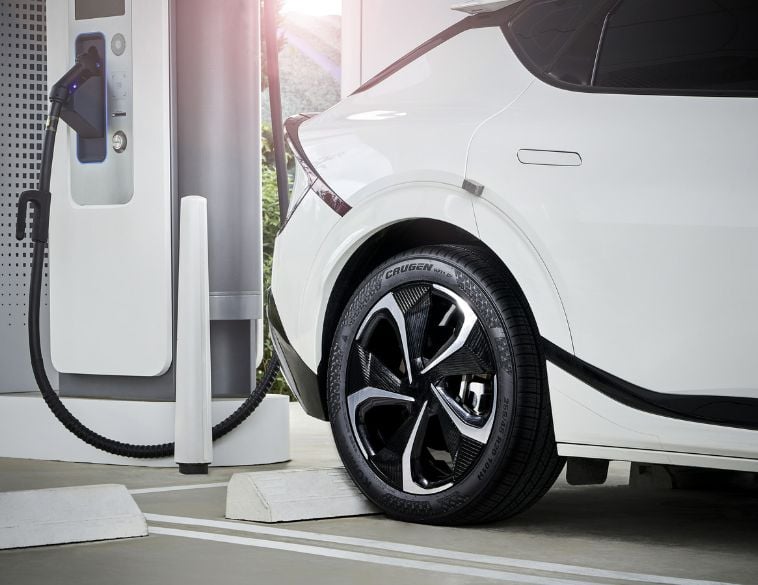Tire retailers are poised to cash in on the growing popularity of the light truck market.
Move over, red convertible, and make room for the new midlife crisis vehicle—the pick-up truck!
“It’s like purses for women and shoes for men,” chuckles Dwayne Sawyer, Director of Sales at Kumho Tire Canada, “…although I’ve seen women with pretty cool customized trucks.”
Sawyer believes the truck segment is popular because of a truck’s every day utility, as well as the many options for personalization. Add lower gas prices into the mix, and it’s a slam dunk. “There are different types of people who buy pick-up trucks,” he says. “The enthusiast wants the look, so they buy the sport, and there are different segments within the segment. There’s a sport look, a heavy duty look, with off-road packages. It’s almost like a culture.
“That’s why there are so many plus sizes for light truck tires. You have up to 38 inch tires or even higher than that. It’s the personalization. These consumers are going for a look even though they’re not necessarily going to use the truck for what the tires were intended.”
Grocery getters
Light truck tire customers look for cosmetic design, highway performance, on and off highway, all terrain, as well as off-road performance for severe conditions. “Price takes a back seat to performance in the light truck tire segment,” says Sawyer. “There are places where you can save money when you buy a light truck. The place where you’re not going to try to save money is on the tires. Customers often rely on the light truck for work or family outings involving towing, and so safety is top of mind.
“It’s crucial for the tire dealer not to make assumptions but ask about the purpose and intended use of the vehicle before proposing a specific pattern or design. Dealers need to listen to these key indicators to make a confident recommendation.”
More and more, trucks are being used as daily drivers. “They’re being used as mom’n’pop vehicles and grocery getters,” says Greg Cressman, Technical Service director at Yokohama (Canada). “People might be looking for a true consumer type vehicle tire, an all-season application tire that they’re going to run in an urban environment—so they’ll want something that’s an all-season tire, that gives them a nice quiet ride, that lasts a long time. And of course, it’s got to fit in the budget.”
Or, the truck might be used in a commercial application, which puts an entirely different spin on the type of tires needed. “If a light truck is working for a living, it’s loaded up every day and drives on various surfaces,” says Cressman. “The tires need to withstand all the trials and tribulations of the job site. You can end up with a whole different set of requirements depending on the surface they’re driving on, how strong they are, what loads they can carry.”
Understand your market
It’s up to retailers to understand what market they’re in to take advantage of this boom in light truck tires. “If you’re in a consumer area, in an urban or suburban market, you’re going to be tailoring your offerings to that market,” says Cressman. “You have to understand your customers, who’s coming through your door, and make sure you offer the types of things that they’re after, have the tires in stock, priced right and serviced properly.”
Appearance and aesthetics are also big factors in the light truck tire world. “We’ve seen a big focus on aesthetics,” says Will Robbins, Product Manager, consumer replacement, Bridgestone Americas. “Especially in the sidewall appearance of a mud terrain tire or an all terrain tire. Previously, those light truck fitments were more commercially focused, and a true commercial use customer isn’t necessarily interested in the aesthetics of the product—they’re more about performance.”
Another big area of growth is with commercial vans, like the Ford Transit or Mercedes Sprinter. “These have seen a significant increase in the past four or five years,” says Robbins. “That’s likely due to e-commerce, where these vehicles are used for local type delivery, supplementing more traditional long-haul trucking to do delivery of e-commerce goods. They’re very effective for urban environments and, with the loading that they can carry with light truck tires, these vehicles can accommodate a lot of packages.”
Grudge purchase
From Darrin Bossence’s perspective, there are two types of light truck tire customers. “The older generation that has either hit mid life crisis, or is close to retirement, and wants the practicality of a pick-up truck,” says the VP of Sales at Dynamic Tire. “They’re happy with the OEM tire that comes on the truck—as long as it’s quiet and rides well, they’re happy.”
The other type is the younger generation, who want to put big rims and big tires, to go with their truck’s lift kit. “The kids are into larger sizing,” notes Bossence. “They want mud terrain tires that they drive on the road.”
In his experience, tires are still a grudge purchase, even in the light truck segment. “Tires are a commodity. No one wants to put out any more than they have to,” Bossence says. “Everyone has a firm understanding of safety and how tires are related to that, but at the end of the day, it comes down to outlay.”
He recommends that retailers offer a ‘good, better, best’ scenario. “You have entry level and ‘good’—the middle of the road tire, which may be a Tier 2 or top of Tier 3—and then Tier 1,” Bossence says. He has found that on the consumer side, as well as the commercial side, people will either go premium or entry level.
Bossence also has observed brand loyalty going by the wayside. “Baby Boomers aren’t concerned about the name on the sidewall. They’re concerned about value,” he says.
“This is a very competitive segment. The consumer has a lot of options and choices, and that’s not going to change any time soon.”



